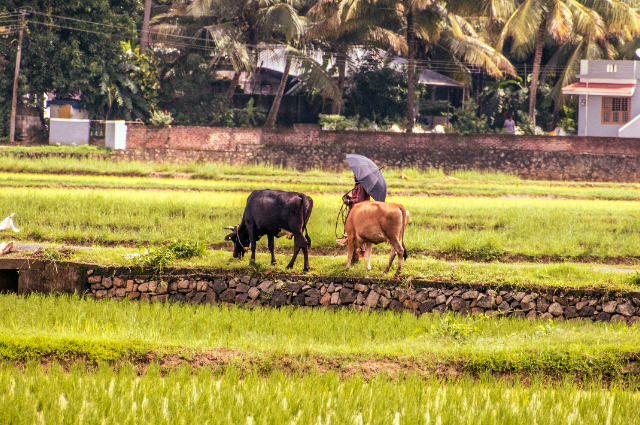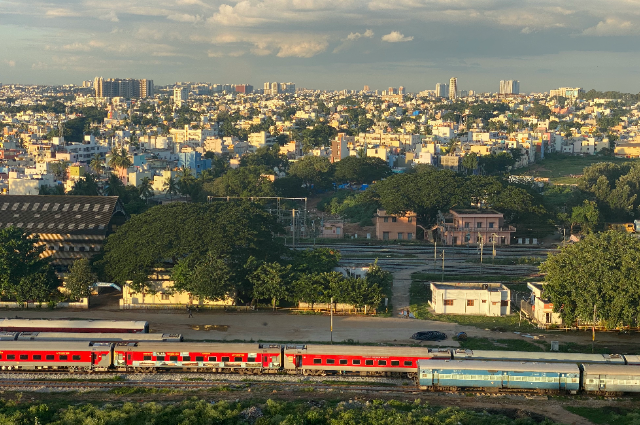
Photo by aboodi vesakaran on Unsplash
Agriculture and Farmers' Welfare
The Union Budget 2024-25 places significant emphasis on agriculture and farmers' welfare, aiming to enhance productivity, resilience, and sustainability within the sector. Key initiatives and measures are tailored to address various aspects of agricultural development.
Promotion of Vegetable Production:
The government aims to bolster the vegetable supply chain by promoting Farmer Producer Organizations (FPOs), cooperatives, and startups. These entities will focus on the collection, storage, and marketing of vegetables, ensuring that farmers receive fair prices and consumers have access to fresh produce.
New Varieties of Crops:
A notable introduction in this budget is the release of 109 new high-yielding and climate-resilient varieties of 32 field and horticulture crops. These varieties are designed to withstand changing climatic conditions, thereby ensuring consistent yields and enhancing food security.
National Cooperation Policy:
To ensure systematic and holistic development of the cooperative sector, a new National Cooperation Policy has been introduced. This policy aims to strengthen cooperatives, making them more efficient and beneficial for their members, which in turn supports rural development.
Atmanirbharta in Oil Seeds:
The budget underscores the importance of self-sufficiency in oil seeds such as mustard, groundnut, sesame, soybean, and sunflower. Efforts will be made to increase domestic production, reducing dependency on imports and improving the livelihood of farmers engaged in oil seed cultivation.
Natural Farming:
A significant push towards sustainable agriculture is evident with the target to initiate 1 crore farmers into natural farming. This will be supported by certification and branding initiatives, along with the establishment of 10,000 bio-input resource centers to provide necessary inputs and guidance.
Shrimp Production and Export:
Recognizing the potential of aquaculture, the budget provides financial support for shrimp farming, processing, and export through the National Bank for Agriculture and Rural Development (NABARD). This initiative aims to enhance production and boost exports, benefiting coastal communities and contributing to the economy.
These comprehensive measures in the Budget 2024-25 reflect a strong commitment to agricultural development, ensuring long-term sustainability and prosperity for farmers across the nation.
Employment and Skilling

Image by Gerd Altmann from Pixabay
The Union Budget 2024-25 places a strong emphasis on creating job opportunities and enhancing skills, recognizing these as crucial elements for economic growth and social development. The budget introduces several innovative schemes aimed at increasing employment, particularly among women and youth, and at boosting skill levels across various sectors.
Women Workforce Participation
To facilitate higher participation of women in the workforce, the budget proposes the establishment of working women hostels and creches. This initiative is designed to provide safe and affordable accommodation and childcare facilities for working women, thereby reducing the barriers that often prevent women from pursuing professional opportunities. By collaborating with industry partners, the government aims to create environments that support women's career aspirations and contribute to a more inclusive and diverse workforce.
PM's Employment Package
The Prime Minister's Employment Package introduces four comprehensive schemes aimed at job creation, particularly targeting the youth. These schemes are strategically designed to address various facets of employment, from incentivizing first-time job seekers to boosting job creation in manufacturing sectors.
Scheme A: Incentives for First-Time Employees and Employers
This scheme aims to encourage first-time employment by offering incentives to both employees and employers. For employees, it provides financial assistance or tax benefits, reducing the initial financial burden of entering the workforce. Employers, on the other hand, receive incentives to hire first-time job seekers, which can include subsidies, tax breaks, or other financial support. This dual approach ensures that the entry barriers for new job seekers are lowered while motivating employers to create more entry-level positions.
Scheme B: Focus on Job Creation in Manufacturing
Recognizing the manufacturing sector as a critical engine of job creation, Scheme B focuses on stimulating employment within this sector. The government plans to introduce policies and incentives that encourage manufacturing companies to expand their workforce. This could include subsidies for setting up new manufacturing units, tax incentives for hiring additional staff, and support for training programs that equip workers with the necessary skills for manufacturing jobs. By bolstering the manufacturing sector, the government aims to generate a significant number of new jobs, contributing to overall economic growth.
Scheme C: Government Reimbursement of Employer EPFO Contributions
Under Scheme C, the government will reimburse employers for their contributions to the Employees' Provident Fund Organisation (EPFO) for new hires. This scheme reduces the financial burden on employers, encouraging them to hire more staff. By covering the EPFO contributions, the government not only incentivizes employment but also ensures that new employees receive social security benefits. This measure is particularly beneficial for small and medium enterprises (SMEs) that often face financial constraints in expanding their workforce.
Skilling Programme
The budget introduces an ambitious skilling program aimed at enhancing the skills of 20 lakh youth over the next five years. This program is designed to equip young people with the skills needed to thrive in a rapidly changing job market. It focuses on both technical and soft skills, ensuring that participants are well-prepared for a variety of job roles. The skilling program will include partnerships with industry leaders, vocational training institutes, and educational institutions to provide comprehensive training modules.
In addition to skilling youth, the program also aims to upgrade 1,000 Industrial Training Institutes (ITIs) across the country. This upgrade will involve modernizing infrastructure, updating curricula, and introducing new courses that align with current industry demands. By enhancing the quality of training provided at ITIs, the government seeks to produce a highly skilled workforce capable of meeting the needs of diverse industries.
Middle Class and Social Justice

Image by Wikipedia
The Union Budget 2024-25 underscores the government's commitment to supporting the middle class and promoting social justice through targeted initiatives and substantial financial allocations. These efforts are designed to enhance economic opportunities, improve socio-economic conditions for marginalized communities, and provide support for infrastructure development. Key highlights of these initiatives are detailed below.
Purvodaya Initiative
The Purvodaya Initiative focuses on the development of economically rich states in Eastern India, aiming to generate substantial economic opportunities and drive balanced regional growth. This initiative targets states like West Bengal, Odisha, Bihar, Jharkhand, and the northeastern states, which have significant untapped potential. By fostering industrial development, infrastructure enhancement, and investment in human capital, the initiative seeks to transform these states into economic powerhouses.
Key components of the Purvodaya Initiative include:
- Industrial Development: Encouraging the establishment of new industries and the expansion of existing ones through incentives and subsidies.
- Infrastructure Improvement: Investing in the development of transportation networks, including roads, railways, and ports, to improve connectivity and support economic activities.
- Skill Development: Implementing comprehensive skill development programs to prepare the local workforce for new job opportunities in emerging industries.
- Investment Promotion: Attracting both domestic and international investments through favorable policies and a conducive business environment.
Pradhan Mantri Janjatiya Unnat Gram Abhiyan
The Pradhan Mantri Janjatiya Unnat Gram Abhiyan aims to improve the socio-economic conditions of tribal communities, ensuring that they benefit from the country's growth and development. This initiative focuses on holistic development, addressing key areas such as education, healthcare, infrastructure, and livelihood opportunities.
Key measures under this program include:
- Education: Establishing schools, colleges, and vocational training centers in tribal areas to enhance educational opportunities and skill development.
- Healthcare: Improving healthcare infrastructure by setting up hospitals, clinics, and mobile health units, and providing training for healthcare professionals in tribal regions. - **Infrastructure**: Developing basic infrastructure such as roads, electricity, and water supply to improve the quality of life in tribal communities.
- Livelihood Support: Implementing programs to promote sustainable agriculture, handicrafts, and other traditional livelihoods, along with providing access to markets and financial services.
Women and Girl Child Development
Recognizing the critical role of women and girls in society's progress, the budget allocates more than ₹3 lakh crore for schemes benefiting them. These schemes are designed to address various aspects of women's and girls' development, from health and education to economic empowerment and safety.
Key initiatives include:
- Healthcare: Enhancing maternal and child healthcare services, providing nutritional support, and ensuring access to essential health facilities.
- Education: Promoting girls' education through scholarships, free textbooks, and improving school infrastructure, particularly in rural and underserved areas.
- Economic Empowerment: Supporting women entrepreneurs through financial assistance, training programs, and market access initiatives.
- Safety and Protection: Strengthening measures to ensure the safety and protection of women and girls, including legal aid, helplines, and support centers for victims of violence.
Financial Support for Andhra Pradesh
The budget allocates ₹15,000 crore to support infrastructure and development projects in Andhra Pradesh as part of the Andhra Pradesh Reorganization Act. This financial support aims to address the developmental needs of the state, ensuring balanced regional development and enhancing the quality of life for its residents.
Key areas of focus include:
- Infrastructure Development: Investing in the construction and upgrade of roads, bridges, and public transportation systems to improve connectivity and support economic activities.
- Industrial Growth: Promoting industrial development through the establishment of industrial parks, special economic zones, and incentives for businesses.
- Educational and Health Infrastructure: Enhancing educational and healthcare facilities to ensure access to quality education and healthcare services for the population.
- Urban and Rural Development: Implementing comprehensive urban and rural development programs to create sustainable and inclusive growth across the state.
Infrastructure Development

Photo by Sanket Shah on Unsplash
The Union Budget 2024-25 dedicates a significant portion to infrastructure development, recognizing its vital role in economic growth and regional development. The budget outlines several key projects and financial allocations aimed at enhancing connectivity, improving water management, and supporting state-level infrastructure initiatives.
Long-Term Loans to States
One of the notable initiatives in the budget is the provision of ₹1.5 lakh crore as interest-free long-term loans to states for resource allocation. This measure is designed to empower states to undertake large-scale infrastructure projects without the burden of interest payments, thereby facilitating faster and more efficient development.
The loans will support a wide range of projects, including:
- Road and Highway Construction: Improving transportation networks to enhance connectivity and reduce travel time.
- Urban Development: Upgrading urban infrastructure, including water supply, sewage systems, and public transport, to improve the quality of life in cities.
- Rural Infrastructure: Developing rural roads, bridges, and community facilities to ensure balanced regional development.
- Renewable Energy Projects: Investing in solar, wind, and other renewable energy projects to promote sustainable energy solutions.
By providing these interest-free loans, the government aims to boost state-level infrastructure projects, stimulate economic activity, and create job opportunities across the country.
PMGSY Phase IV
The Pradhan Mantri Gram Sadak Yojana (PMGSY) Phase IV aims to provide all-weather connectivity to 25,000 rural habitations. This initiative is crucial for integrating rural areas with mainstream economic activities, facilitating access to markets, healthcare, and educational institutions.
Key features of PMGSY Phase IV include:
- Road Construction and Upgradation: Building new roads and upgrading existing ones to ensure they are durable and can withstand various weather conditions.
- Sustainable Practices: Incorporating sustainable construction practices and materials to enhance the longevity and environmental compatibility of rural roads.
- Community Involvement: Engaging local communities in the planning and execution of road projects to ensure that the infrastructure meets their specific needs and preferences.
- Monitoring and Maintenance: Implementing robust monitoring and maintenance mechanisms to ensure the long-term sustainability of the road infrastructure.
By enhancing rural connectivity, PMGSY Phase IV aims to improve the socio-economic conditions of rural populations, reduce rural-urban migration, and support agricultural and non-agricultural activities in these areas.
Irrigation and Flood Mitigation
The budget also allocates substantial financial support for various irrigation and flood management projects, particularly in states like Himachal Pradesh, Assam, Sikkim, and Uttarakhand. These projects are essential for ensuring water security, enhancing agricultural productivity, and protecting communities from the adverse effects of floods.
Key initiatives in this area include:
- Irrigation Infrastructure: Developing and upgrading irrigation systems to provide reliable water supply for agriculture, thereby increasing crop yields and supporting farmers' livelihoods. This includes the construction of canals, dams, and water storage facilities.
- Flood Management: Implementing comprehensive flood management systems to mitigate the impact of floods. This involves constructing flood barriers, improving drainage systems, and developing early warning systems to protect vulnerable communities.
- Watershed Development: Promoting watershed development projects to enhance water retention, recharge groundwater, and prevent soil erosion. These projects are particularly important for maintaining ecological balance and supporting sustainable agriculture in hilly regions.
- Community Engagement: Involving local communities in the planning and implementation of water management projects to ensure that they address local needs and contribute to the overall resilience of the region.
By focusing on irrigation and flood mitigation, the budget aims to enhance agricultural productivity, ensure water security, and protect communities from the devastating effects of floods, thereby supporting sustainable development in these states.
Tax Reforms and Proposals

Photo by Jakub Żerdzicki on Unsplash
The Union Budget 2024-25 introduces significant tax reforms and proposals aimed at simplifying the tax regime, providing relief to citizens, and enhancing the competitiveness of various sectors. These measures reflect the government's commitment to fostering a conducive environment for economic growth and ensuring that the tax system is fair, efficient, and supportive of both individuals and businesses.
Income Tax Reforms
One of the key highlights of the budget is the introduction of several reforms in the income tax system, which aim to ease the tax burden on salaried employees and make the tax regime more straightforward and accessible.
- Increased Standard Deduction for Salaried Employees: The budget increases the standard deduction for salaried employees, providing immediate tax relief and enhancing disposable income. This measure is expected to benefit millions of employees by reducing their taxable income and increasing their take-home pay, thereby boosting consumer spending and overall economic activity.
- Simplified Tax Regime: The introduction of a simplified tax regime aims to make tax compliance easier for individuals. This includes reducing the number of tax brackets and simplifying the process of filing tax returns. By streamlining the tax structure, the government seeks to reduce the administrative burden on taxpayers and improve compliance rates.
- Increased Exemption Limits for Capital Gains: The budget proposes to increase the exemption limits for capital gains, particularly for investments in equity and real estate. This measure is designed to encourage investment by reducing the tax liability on capital gains, thereby promoting long-term savings and investment in growth-oriented assets.
Custom Duty Reforms
To enhance the competitiveness of various sectors and support strategic industries, the budget includes several custom duty reforms. These reforms aim to reduce the cost of imports, stimulate domestic manufacturing, and promote exports.
- Reduction in Custom Duties for Various Sectors: The budget proposes a reduction in custom duties for key sectors such as electronics, automotive, and pharmaceuticals. By lowering the cost of imported inputs and raw materials, this measure aims to enhance the competitiveness of domestic industries, promote manufacturing, and support the Make in India initiative.
- Support for Strategic Industries: Custom duty reductions are also targeted at strategic industries such as defense, aerospace, and renewable energy. By reducing the cost of critical components and technologies, the government seeks to promote the development of these high-value sectors, attract investment, and boost exports.
Direct Tax Proposals
The budget introduces several direct tax proposals aimed at rationalizing tax rates, eliminating outdated taxes, and reducing the tax burden on foreign companies operating in India.
- Rationalization of Capital Gains Tax Rates: The budget proposes to rationalize capital gains tax rates to create a more equitable and efficient tax system. This includes aligning the tax rates across different asset classes and simplifying the tax calculation process. The goal is to reduce distortions in investment decisions and encourage long-term investments in productive assets.
- Abolition of ANGEL Tax for All Investors: In a significant move to support the startup ecosystem, the budget abolishes the ANGEL tax for all investors. The ANGEL tax, which was levied on investments received by startups, has been a contentious issue, often leading to tax disputes and hindering the flow of capital to startups. By abolishing this tax, the government aims to create a more favorable environment for startups, encourage innovation, and attract both domestic and foreign investment in the entrepreneurial ecosystem.
- Reduced Corporate Tax Rates for Foreign Companies: To attract more foreign direct investment (FDI) and promote India as a global business hub, the budget proposes to reduce corporate tax rates for foreign companies. This measure is expected to make India a more attractive destination for multinational corporations, stimulate investment, create jobs, and boost economic growth.
Economic Foundations

Image by Gerd Altmann from Pixabay
The Union Budget 2024-25 emphasizes strengthening the economic foundations of the country with a focus on robust growth and fiscal prudence. Key strategies include targeting a substantial real GDP growth rate, managing inflation and fiscal deficit, and ensuring the continued decline in non-performing assets (NPAs) of scheduled commercial banks. These measures are aimed at fostering a stable and dynamic economic environment conducive to sustainable development.
Real GDP Growth
A central goal of the budget is to achieve a targeted real GDP growth rate of 8.2% for FY 2024. This ambitious target reflects the government's commitment to accelerating economic expansion through various strategic initiatives and reforms. Key factors contributing to this growth target include:
- Infrastructure Development: Significant investments in infrastructure projects are expected to stimulate economic activity across various sectors. The development of roads, railways, ports, and urban infrastructure will not only create jobs but also improve productivity and connectivity, fostering long-term economic growth.
- Industrial Growth and Manufacturing: Policies aimed at boosting industrial growth and manufacturing are central to achieving the GDP growth target. Initiatives such as the Make in India program, incentives for domestic production, and support for small and medium enterprises (SMEs) are designed to enhance industrial output and competitiveness.
- Technology and Innovation: Promoting technology adoption and innovation is another critical aspect. The budget emphasizes support for startups, research and development (R&D), and digital transformation across industries, which are expected to drive productivity gains and economic dynamism.
- Agriculture and Rural Development: Enhancing agricultural productivity and rural development is essential for inclusive growth. Initiatives to support farmers, improve rural infrastructure, and promote agri-businesses are expected to contribute significantly to overall economic performance.
Inflation and Fiscal Deficit Management
Managing inflation and reducing the fiscal deficit are key priorities in the budget to ensure macroeconomic stability and fiscal prudence. Inflation, including supply-side interventions to address bottlenecks, improving agricultural productivity, and stabilizing food prices. By ensuring adequate supply of essential commodities and maintaining price stability, the government aims to protect consumers' purchasing power and maintain economic stability.
- Fiscal Deficit Reduction: A crucial aspect of fiscal prudence is the targeted reduction of the fiscal deficit as a percentage of GDP. The budget proposes a balanced approach to fiscal consolidation, combining expenditure rationalization with revenue enhancement measures. Key strategies include:
- Expenditure Rationalization: Streamlining government spending by prioritizing high-impact projects and curbing non-essential expenditures. This includes better targeting of subsidies and improving efficiency in public sector undertakings.
- Revenue Mobilization: Enhancing revenue through tax reforms, broadening the tax base, and improving tax compliance. The budget also explores avenues for increasing non-tax revenues, such as disinvestment and monetization of government assets.
Decline in NPAs
A continued decline in gross non-performing assets (NPAs) of scheduled commercial banks is a key indicator of improving financial stability and health of the banking sector. The budget highlights several measures to support this trend:
- Strengthening Financial Sector Regulations: Enhancing the regulatory framework to ensure better risk management, transparency, and accountability in the banking sector. This includes stricter oversight of lending practices and improved mechanisms for early detection and resolution of stressed assets.
- Recapitalization of Banks: Provisioning adequate capital to public sector banks to strengthen their balance sheets and enhance their lending capacity. This measure aims to support credit growth, particularly to priority sectors, and ensure financial stability.
- Insolvency and Bankruptcy Code (IBC) Reforms: Further strengthening the IBC framework to expedite the resolution of bad loans and improve recovery rates. Effective implementation of the IBC is crucial for timely resolution of stressed assets and minimizing losses to creditors.
- Promoting Digital Banking and Financial Inclusion: Encouraging digital banking and financial inclusion initiatives to improve access to financial services, reduce transaction costs, and enhance the efficiency of the banking system. Increased adoption of digital technologies is expected to reduce operational risks and improve overall financial health.
Energy and Climate

The Union Budget 2024-25 introduces several initiatives aimed at ensuring energy security and supporting the transition to clean energy. Recognizing the critical importance of sustainable energy practices in mitigating climate change, these initiatives focus on the development of nuclear energy, integration of renewable energy sources, and financial support for industries shifting to cleaner energy. These measures are designed to enhance the country's energy independence, reduce carbon emissions, and promote environmental sustainability.
Bharat Small Reactors
One of the significant steps in the budget is the setting up of small modular reactors (SMRs) and research and development (R&D) for nuclear energy under the Bharat Small Reactors initiative. This initiative is poised to play a crucial role in meeting the country's growing energy demands while minimizing environmental impact.
- Small Modular Reactors (SMRs): SMRs are advanced nuclear reactors with a capacity of up to 300 megawatts, offering several advantages over traditional large-scale nuclear plants. They are designed to be safer, more efficient, and cost-effective. The budget emphasizes the development and deployment of SMRs to provide a reliable and continuous power supply, particularly in remote and underserved regions.
- R&D for Nuclear Energy: The government is committed to investing in research and development to advance nuclear technology. This includes improving reactor safety, enhancing fuel efficiency, and developing new materials and technologies to support the sustainable growth of nuclear energy. By fostering innovation in this field, the government aims to position India as a leader in clean and safe nuclear energy.
Pumped Storage Policy
The budget also introduces the Pumped Storage Policy to facilitate the integration of renewable energy sources and enhance the stability of the power grid. This policy aims to address the intermittency of renewable energy sources like solar and wind by leveraging pumped storage technology.
- Joint Ventures for Commercial Plants: The policy encourages the establishment of joint ventures between public and private entities to develop commercial pumped storage plants. These plants use surplus energy during off-peak hours to pump water to a higher elevation, which is then released to generate electricity during peak demand periods. This approach helps balance the supply and demand of electricity, ensuring a stable and reliable power supply.
- Energy Audits and Renewable Integration: The policy also includes provisions for conducting energy audits to identify inefficiencies and optimize the integration of renewable energy into the grid. By assessing energy usage patterns and implementing corrective measures, the government aims to enhance the overall efficiency of the power system and reduce dependency on fossil fuels.
PM Surya Ghar Muft Bijli Yojana
The PM Surya Ghar Muft Bijli Yojana is a landmark initiative designed to support micro and small industries in transitioning to cleaner energy forms. This scheme provides financial assistance to these industries to adopt renewable energy solutions, thereby reducing their carbon footprint and promoting sustainable industrial growth.
- Financial Support for Clean Energy Transition: Under this scheme, micro and small industries receive financial support to install solar panels, wind turbines, and other renewable energy systems. This assistance covers a significant portion of the installation costs, making it financially viable for small businesses to switch to cleaner energy.
- Promoting Energy Efficiency: The scheme also emphasizes the importance of energy efficiency. Industries are encouraged to implement energy-saving measures, such as using energy-efficient equipment and adopting best practices in energy management. By reducing energy consumption, these measures contribute to lower operating costs and enhanced competitiveness.
- Environmental Benefits: The adoption of cleaner energy forms under this scheme leads to a substantial reduction in greenhouse gas emissions. This not only helps in combating climate change but also improves air quality and public health. The scheme aligns with India's commitment to international climate goals and demonstrates the country's leadership in sustainable development.
